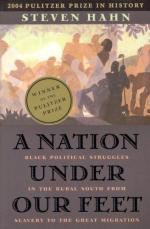
|
| Name: _________________________ | Period: ___________________ |
This test consists of 15 multiple choice questions and 5 short answer questions.
Multiple Choice Questions
1. The Friends of Universal ________ in Louisiana sought more radical reforms during this time.
(a) Suffrage.
(b) Freedom.
(c) Property.
(d) Rights.
2. Congress gave the federal government the ability to restructure the ______________ states.
(a) Union.
(b) Confederate.
(c) Western.
(d) Slave owner.
3. General Benjamin F. Butler declared slaves ______________ of war and put them to work.
(a) Contraband.
(b) Spoils.
(c) Victims.
(d) Prisoners.
4. The delegates who gathered in state __________ that year were composed of both black and white men.
(a) Capitols.
(b) Board rooms.
(c) Parks.
(d) Farming communities.
5. In 1862, the War Department authorized the establishment of a ______________.
(a) Black regiment.
(b) Confederate dissolution.
(c) White and black regiment.
(d) Union spy team.
6. The __________ process helped to illuminate who the leaders were within black communities.
(a) Labor.
(b) Slave.
(c) Registration.
(d) Draft.
7. Black support fed on the ideologies and customers with _______________.
(a) Families.
(b) Churches.
(c) Armies.
(d) Black communities.
8. Few slaves knew how to ___________ before they entered the military.
(a) March.
(b) Shoot a gun.
(c) Read or write.
(d) Take orders.
9. What kind of winds blew into the United States during the 1850s, according to Hahn's book?
(a) Liberal.
(b) Conservative.
(c) Strong.
(d) Weak.
10. By drilling, marching, and posting sentinels, ___________ reminded each other of the risks they faced while offering protection.
(a) Women.
(b) Young men.
(c) Slaves.
(d) Freed people.
11. African Americans exposed the complex and contradictory relationship between labor and _____________.
(a) Freedom.
(b) Peace.
(c) Democracy.
(d) Rights.
12. The League depended on a wider base of mobilization and involvement than ____________.
(a) Laws.
(b) Membership.
(c) Society.
(d) Money.
13. About one in ________ slaves lived in the upper or border South, where the hiring of free people of color was not uncommon.
(a) Eight.
(b) Ten.
(c) Four.
(d) Five.
14. Hahn is mindful of overemphasizing the number of _________ which formed during these periods of time.
(a) Solidarities.
(b) Lynchings.
(c) White groups.
(d) Voting rules.
15. Some slaveholders began offering their slaves small ___________ in order to keep them on the plantations.
(a) Wages.
(b) Bribes.
(c) Pieces of land.
(d) Houses.
Short Answer Questions
1. Even before the presidential election took place, rumors were circulating that ___________ had won.
2. Some called for a nation based on a concept of _______________ that was based on birth and loyalty, servitude, or other particularities.
3. This is a book about ___________ people who did extraordinary things under the most difficult of circumstances, writes Hahn.
4. As the __________ government organized, opportunities increased for slaves to become better acquainted with each other and political events.
5. David Medlock was an African American leader in the state of _____________.
|
This section contains 387 words (approx. 2 pages at 300 words per page) |

|




